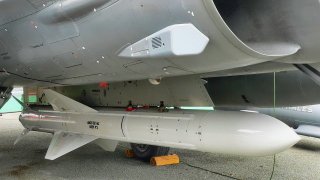France’s Exocet Missile was Built for 1 Thing
The Exocet has become one of the most well-known (and feared) anti-ship missiles in the history of naval warfare. Its introduction changed naval combat strategies in the late twentieth century.
France may not be a superpower, but it does have an impressive and modern military. Indeed, it might very well be the most powerful military that is indigenous to Europe. Possessing a medium-sized nuclear arsenal, France has committed to being able to hold its own in military matters, even against the big dogs like America or Russia. France’s defense industry has an impressive record of creating popular, heavily exported weapons, too.
One such example of this dynamic defense industry is the Exocet missile.
Developed by the French company Aérospatiale (now MBDA), the Exocet has become one of the most well-known (and feared) anti-ship missiles in the history of naval warfare. Its introduction changed naval combat strategies in the late twentieth century. What’s more, the Exocet had a significant impact on wars fought throughout the world at that time.
One notable example was when a French-built Exocet missile that had been purchased by Saddam Hussein’s Iraqi military was fired at a U.S. Navy warship, the USS Stark, during the Tanker War between Iraq and Iran. An Iraqi jet popped off a pair of Exocets at the Stark. The warship could not defend itself against the attack and thirty-seven U.S. sailors were killed with an additional twenty-one being wounded as a result of the attack. The incident continues to be among the worst modern U.S. Navy disasters at sea.
A Brief History
First launched into service by the French in 1967 as a response to the increasing threat of anti-ship warfare in an age when naval supremacy was crucial for geopolitical influence, the French envisaged this weapon system being a relatively cheap method for keeping rivals (and possibly even some allies) on their backfoot. Indeed, according to Defence Encyclopedia, the French Exocet missile was the “only missile that dented” both American and British pride because of its brilliant design and lethal history.
The name “Exocet” comes from the French term for “flying fish.” The name itself reflects the nature of the weapon, what with its low-altitude sea-skimming flight path which makes it difficult to detect on radar. The initial version of the missile, the MM38, was introduced in 1975 and designed from launch from naval ships. Subsequent versions, including the air-launched AM39 and the submarine-launched SM39, expanded its tactical flexibility.
Exocet’s design focuses on simplicity and reliability. It is powered by a solid-propellant booster and a liquid-fuel sustainer engine, allowing for a range of up to 70 kilometers for the MM38, with later models, like the AM39, extending this to around 180 kilometers. The missile’s speed, approximately Mach 0.9, combined with its radar-guided terminal phase, is what gives the crews of ships targeted by this system nightmares. The Exocet anti-ship missile uses active radar homing on its final approach to the target, meaning it can autonomously guide itself right into its target, reducing the need for continuous guidance from the launch platform.
The First Time Exocets Were Used (Against the British)
The Exocet’s first use in war was during the British and Argentinian conflict over the Falkland Islands in 1982. Argentine forces, seeking to evict the British from the tiny islands in the South Atlantic, used the French-made Exocet missiles against British warships, most notably damaging the HMS Sheffield as well as the British Merchant Navy ship the SS Atlantic Conveyor.
These incidents underscored the missile’s lethality and highlighted multiple vulnerabilities in the defenses of the world’s leading Western navies. Because of its successful demonstration by the Argentine military against the British Royal Navy, the French saw interest spike among potential foreign buyers.
In fact, the presence of these Exocet missiles in a given theater of operation could fundamentally alter the balance of military power in that region, prompting a great race for these systems—much to the benefit of France’s military and economy.
The Results
Navies around the world responded to this new French missile by making changes to their naval radar systems, electronic countermeasures, and ship design to better counter the low-flying missile threat that the Exocet presented. Therefore, navies began prioritizing the concept of “stealth” at sea, inevitably leading to warship designs that minimized radar cross-sections.
Between the early Argentine example and the eventual use by Saddam’s Iraqi military, both the British and American navies were—however briefly—humiliated by this simple, yet effective, French missile.
Whatever one thinks of its ramifications, the fact remains that the French have proven themselves to be an enduring great military power with the creation, production, and widespread use of the Exocet anti-ship missile for the last fifty-seven years.
Brandon J. Weichert, a National Interest national security analyst, is a former Congressional staffer and geopolitical analyst who is a contributor at The Washington Times, the Asia Times, and The-Pipeline. He is the author of Winning Space: How America Remains a Superpower, Biohacked: China’s Race to Control Life, and The Shadow War: Iran’s Quest for Supremacy. His next book, A Disaster of Our Own Making: How the West Lost Ukraine, is available for purchase wherever books are sold. Weichert can be followed via Twitter @WeTheBrandon.

